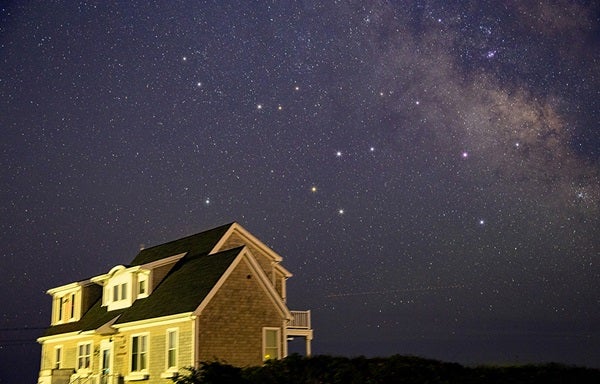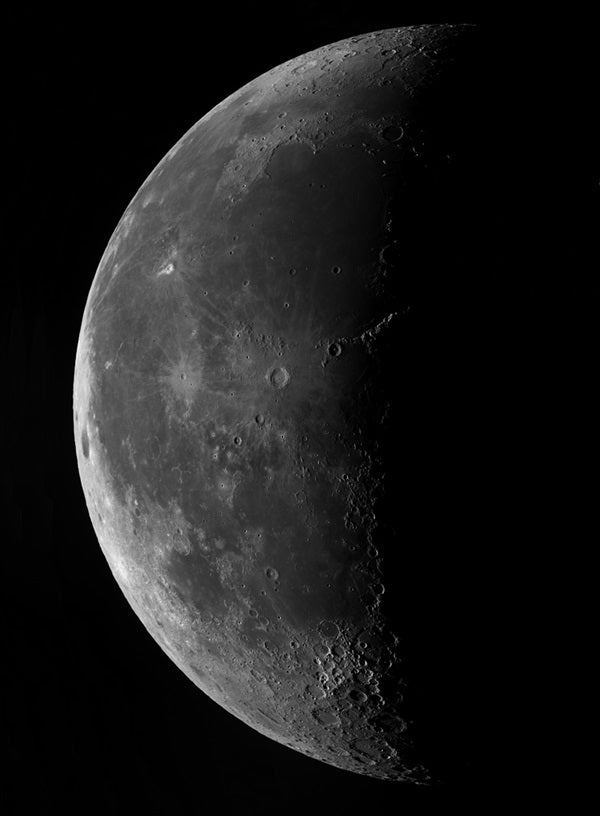Asteroid 15 Eunomia reached opposition and peak visibility just four days ago, and the view tonight is essentially the same. The main-belt object traverses the sky from dusk to dawn and climbs halfway to the zenith in the southern sky around 1 a.m. local daylight time. Eunomia shines at magnitude 8.2 and should be easy to find through binoculars under a dark sky and in a 4-inch telescope from the suburbs. The asteroid is currently moving westward against the backdrop of Aquarius the Water-bearer. Tonight, it lies 4.3° due west of magnitude 2.9 Beta (β) Aquarii.

Bringing the universe to your door. We’re excited to announce Astronomy magazine’s new Space and Beyond subscription box – a quarterly adventure, curated with an astronomy-themed collection in every box. Learn More >>.
Saturday, August 17
Mercury reached greatest western elongation August 9, but it is actually easier to see before dawn this weekend. The innermost planet rises nearly 90 minutes before the Sun and climbs 6° high in the east-northeast 45 minutes before sunup. But the reason it is so simple to see is because it shines so brightly. At magnitude –0.9, it appears more than twice as bright as it did at greatest elongation. If you have trouble spotting the planet with your naked eye, scan the area with binoculars. When viewed through a telescope, Mercury shows a disk that spans 6.2″ and appears about two-thirds lit.
The Moon reaches apogee, the farthest point in its orbit around Earth, at 6:49 a.m. EDT. It then lies 252,429 miles (406,244 kilometers) from Earth’s center.
Sunday, August 18
For those of you up for an observing challenge, try to spot Pluto this evening. The dwarf planet glows at 14th magnitude and shows up as a faint pinprick of light through 8-inch or larger telescopes from under a dark sky. The key is to have a go-to telescope or be able to star-hop from a relatively bright (though still dim) star. Tonight offers a prime opportunity, as Pluto slides 12′ due north of magnitude 9.4 HD 183431. And tomorrow night, the distant world slides just 2′ north of a magnitude 10.5 field star.
Monday, August 19
Evenings this week are great times to explore the constellation Sagittarius the Archer. This star group lies due south and at peak altitude around 10 p.m. local daylight time, shortly after the last vestiges of twilight have faded away. The brightest stars within the constellation form the shape of a teapot — a distinctive asterism once you’ve found it. The central regions of the Milky Way pass through Sagittarius, so it’s always worth exploring the area through binoculars or a telescope.
Although Jupiter reached opposition and peak visibility more than two months ago, it still dominates the sky from shortly after sunset until past midnight. It lies against the backdrop of southern Ophiuchus the Serpent-bearer and appears some 25° in the south-southwest as twilight fades to darkness. Shining at magnitude –2.3, Jupiter is the night sky’s most conspicuous object until the Moon rises in late evening. When viewed through a telescope, the planet shows a 40″-diameter disk and striking cloud-top detail. You’ll also see the gas giant’s four bright Galilean moons. Because they all glow around 5th magnitude, it can often be difficult to tell apart. But this evening it’s a piece of cake because they line up in order of their distance east of the planet, with Io closest to Jupiter followed by Europa, Ganymede, and Callisto.
Wednesday, August 21
Magnificent Saturn reached its peak six weeks ago, when it appeared opposite the Sun in the sky, and our view of the ringed planet remains spectacular. It resides among the background stars of Sagittarius the Archer, a region that appears highest in the south around 10 p.m. local daylight time and doesn’t set until 2 a.m. Saturn continues to shine brightly, too, at magnitude 0.3. When viewed through a telescope, the planet’s disk measures 18″ across while the dramatic ring system spans 41″ and tilts 25° to our line of sight.
Thursday, August 22
The constellations Ursa Major the Great Bear and Cassiopeia the Queen lie on opposite sides of the North Celestial Pole, so they appear to pivot around the North Star (Polaris) throughout the course of the night and the year. In late August and early September, these two constellations appear equally high as darkness falls. You can find Ursa Major and its prominent asterism, the Big Dipper, about 30° above the northwestern horizon. Cassiopeia’s familiar W-shape, which currently lies on its side, appears the same height above the northeastern horizon. As the night progresses, Cassiopeia climbs above Polaris while the Big Dipper swings below.
Last Quarter Moon arrives at 10:56 a.m. EDT. It rose in the east-northeast late yesterday evening (shortly before midnight) and climbs high in the southeast before dawn. During this period, our half-lit satellite lies among the background stars of western Taurus the Bull.
Saturday, August 24
Look for the waning crescent Moon this morning as it hovers just east of the Hyades star cluster in Taurus the Bull. The two objects clear the horizon by 1 a.m. local daylight time and climb halfway to the zenith by the time morning twilight begins. The Moon appears about 40 percent lit and easily outshines the stars of the V-shaped Hyades. First-magnitude Aldebaran, which marks one tip of the V, appears brighter than the rest of the cluster’s stars because it actually lies in the foreground.
Sunday, August 25
Jupiter has been heading eastward relative to the background stars ever since it reached its stationary point August 11. This slow motion gives observers multiple chances to see the planet skirt the edge of the 10th-magnitude globular star cluster NGC 6235. Jupiter remains silhouetted against the cluster’s southern perimeter from this evening through the 27th. Although the giant world’s brilliance renders NGC 6235 barely visible through most telescopes, imagers should be able to capture both.
Mars reaches the farthest point in its orbit around the Sun at 9 p.m. EDT. At this so-called aphelion, the Red Planet lies 154.9 million miles (249.2 million km) from our star. Mars is now lost in the solar glare, but it will return to view this fall to start an impressive apparition that will culminate in October 2020.












